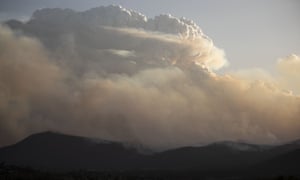There was a near doubling of the record of pyrocumulonimbus (pyroCB) storms, royal commission hears
Australia experienced more supersized weather-generating fires in the
2019-20 bushfire season than in the previous 30 years, the royal
commission into national natural disaster arrangements has heard.
Huge thunderstorm-type clouds called pyrocumulonimbus form over fires in particularly hot, dry and dangerous conditions and are capable of generating their own winds and lightning.
They were once considered “bushfire oddities” but last summer there was a “near doubling of the record of these events, in one event,” Prof David Bowman told the royal commission on Tuesday.
Bowman, a professor of environmental change biology at the University of Tasmania, said the prevalence of pyrocumulonimbus in the most recent bushfire season was “truly extraordinary”.
“So something happened this last summer which is truly extraordinary,
because what we would call statistically a black swan event, we saw a
flock of black swans,” he said. “That just shouldn’t have happened.”Huge thunderstorm-type clouds called pyrocumulonimbus form over fires in particularly hot, dry and dangerous conditions and are capable of generating their own winds and lightning.
They were once considered “bushfire oddities” but last summer there was a “near doubling of the record of these events, in one event,” Prof David Bowman told the royal commission on Tuesday.
Bowman, a professor of environmental change biology at the University of Tasmania, said the prevalence of pyrocumulonimbus in the most recent bushfire season was “truly extraordinary”.
The royal commission has also received 26,257 documents, totalling 320,682 pages.
Bowman, giving evidence alongside Prof Ross Bradstock, from the University of Wollongong centre for environmental risk management of bushfires, and Associate Prof Kevin Tolhurst, from the University of Melbourne, said hazard reduction was not as simple as reducing fuel to reduce risk.
In some cases, he said, a fuel reduction burn could lead to increased bushfire risk.
“Inappropriate fire management could drive a system to become more combustible because, for instance, there is much more fine fuel mass such as grass,” Bowman said. “That’s why fire management is so complicated, because it’s not simply turning off switches. As you change the repertoire of fuel types, trying to change fire behaviour, there is a recursive reaction where the system will also start changing as well.”
Bowman said that change was compounded when you had both fire and drought, which could work together to fundamentally change ecosystems. He said that was already being seen with snow gum forests in the Australian alps.
It’s “the vegetation equivalent of an ice sheet breaking up as the climate is becoming more fire prone and drier. The old vegetation types are not just going to slowly change and migrate, but be burned up.”
Tolhurst said fuel reduction burns were less effective under catastrophic conditions. In mild conditions a hazard reduction burn conducted five or 10 years ago might slow the spread of fire, but in catastrophic conditions fuel reduction burns were only really effective if conducted in the past 12 months, he said.
He suggested Australia had become so effective at putting out naturally-occurring wildfires, such as those sparked by lightning, that it should look at putting more fire back into the landscape for ecological reasons. But Bradstock disagreed with that suggestion, saying that some naturally-occurring wildfires, such as the Gospers Mountain fire, burned extensive areas relatively unchecked.
All three agreed hazard reduction burns were most effective, and most expensive, when they were targeted at protecting built assets such as homes and schools. They said some ecosystems, such as tall, wet forests, did not lend themselves to hazard reduction burns because they burned only under very dangerous conditions and therefore could not be safely managed.
Bradstock said that even though targeted burns were the most expensive to conduct, they were the most cost-effective in reducing damage. And he argued that given the limited budgets of firefighting agencies, they could not justify doing larger landscape burns to protect ecological values and leave built-up areas unprotected.
“When you’ve got limited budgets and limited opportunities, then people will be brutally exposed if they do not prioritise treatments in a cost-effective way to mitigate risk to people and property,” he said.

No comments:
Post a Comment